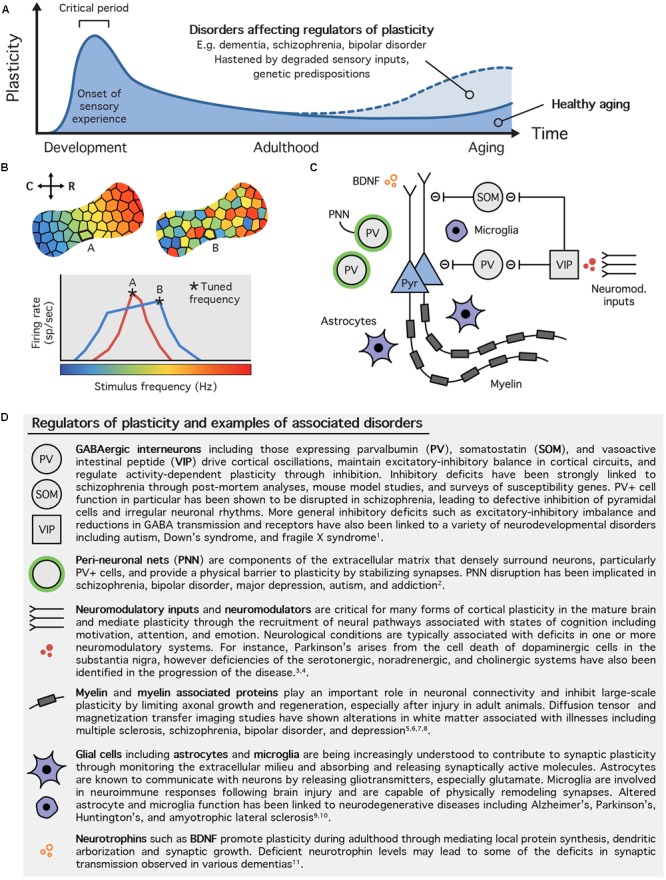FIGURE 1.

Regulation of experience dependent plasticity. (A) Trajectory of experience dependent plasticity during the lifetime. The onset of sensory experience triggers the opening of critical period windows during which the sensory cortex is rapidly organized in response to passive stimulation from the external environment. With maturation, the critical period closes and sensory representations are stabilized. Plasticity continues to take place during adulthood but is tightly regulated by a variety of cellular and molecular processes. These mechanisms tend to decrease with age allowing for non-specific passive experience to elicit plasticity during aging. Disorders that affect regulators of plasticity increase the likelihood for maladaptive plastic changes to take place in the brain. (B) Auditory tonotopic map plasticity. Example of a mature tonotopic map from the rat primary auditory cortex (top left) and that of a rat demonstrating irregular plasticity (top right). The tonotopic map typically exhibits a smooth gradient with neurons in the most caudal (C) part of the cortex firing preferentially (or tuned to) low frequencies and neurons in the most rostral (R) part tuned to high frequencies. In unusual plastic states, such as aging and after long-term exposure to white noise, this functional gradient becomes disrupted as tuning of individual neurons becomes less selective (bottom). For example, a neuron’s tuning may shift from being narrow and selective (site A – red line) to broad and flat peaked (site B – blue line), sometimes altering its tuning frequency (A,B based on Cisneros-Franco et al., unpublished and Thomas et al., unpublished). (C) Some of the major regulators of plasticity in the auditory cortex. Plasticity regulators limit plasticity in the mature brain by controlling the activity of excitatory cells, primarily pyramidal (Pyr) neurons. They include cells such as inhibitory interneurons and glia, structural molecules like peri-neuronal nets and myelin associated proteins, neuromodulatory control from other brain regions, and neurotrophic factors. (D) Table of regulators of plasticity and associated disorders. Altered neuroplasticity has been implicated in a variety of neurological disorders including psychiatric, neurodevelopmental, and neurodegenerative disorders. This table highlights just a few examples of disorders associated with specific regulators of plasticity. References: (1) Marín, 2012 (Review); (2) Sorg et al., 2016; (3) Brichta et al., 2013 (Review); (4) Higley and Picciotto, 2014; (5) Wen et al., 2014; (6) Bellani et al., 2016; (7) Mighdoll et al., 2015; (8) Mandl et al., 2015; (9) Singh and Abraham, 2017 (Review); (10) Morris et al., 2013; (11) Arancio and Chao, 2007.
